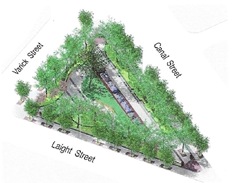CaVaLA Park in Lower Manhattan
 It’s a tough assignment to design a city park that is bordered entirely by lanes of impatient traffic, and the recently completed CaVaLa Park on the border between Tribeca and Soho was a tall order. For years it was a roughly cobbled triangular no man’s land that collected debris and crookedly parked trucks in between their way to elsewhere. In 2005 it was transferred from the DOT to the Parks Department and morphed into a half-grassed field with a pile of stones at one end and a jumble of concrete traffic barriers at the other.
It’s a tough assignment to design a city park that is bordered entirely by lanes of impatient traffic, and the recently completed CaVaLa Park on the border between Tribeca and Soho was a tall order. For years it was a roughly cobbled triangular no man’s land that collected debris and crookedly parked trucks in between their way to elsewhere. In 2005 it was transferred from the DOT to the Parks Department and morphed into a half-grassed field with a pile of stones at one end and a jumble of concrete traffic barriers at the other.
It turned out that the Tribeca Film Festival had contributed the money for the grass so that patrons to their theater – across the street from the park – could stroll in it, but given the uncut grass and the litter, it wasn’t surprising that none of them seemed to take advantage of the opportunity. A couple of years ago the triangle sprouted sidewalks and there were rumors of a park for the site, but that was it – until this year.
This spring the backhoes and dump trucks descended. When they departed in June, they left a patch of the original grass that now runs alongside a water sculpture by Elyn Zimmerman. The six-foot-wide stone piece starts at the park’s west end with a small waterfall that drops into a ‘canal,’ and flows down its 113 feet in three levels via two short cascades into a large grating. The grass patch and the sculpture are now surrounded by curving paved walks, beds of trees, shrubs and flowers, and a handsome cast iron fence.
The park is of course at the awkward stage at this point. Its true merits won’t be seen until plants and shrubs take hold, and the spindly young trees grow and stretch their canopy to provide badly needed enclosure and shade to this hyper-exposed venue. But some of its good points are visible, chiefly the overall layout. It is graciously accessed from each of its three corners, and the curve of its three paths welcomes the walker from the straight ways surrounding it. The railings are graceful and unobtrusive, painted a pale gray. Only waist high, they enclose the park without imprisoning it.
The water sculpture, however, while not a disaster, is a complete miss. It shouldn’t have been. It was created by the brilliant sculptor Elyn Zimmerman, many of whose monumental works, which often include water as an element, are a pleasure to behold. But part of the problem with the work is the difficulty of ‘beholding’ it at all. The sculpture can only be fully seen from one angle – when the park is entered from the east. If you enter the park from the west, all you see is stone wall. If you sit on a bench beside the sculpture, all you can really see are the marble side walls that enclose the channel. Even when you walk in from the southwest, you can’t see much of the water. And in this noisy area, the minimal sound of the water flowing over the two short cascades is entirely drowned out by the sounds of rushing traffic.
The plantings are well arranged but don’t make a lot of sense in terms of maintenance. Although this is not a park like Hudson River Park which has full-time maintenance crews, CaVaLa sports at least a dozen varieties of shrubs and flowering plants, each of which will have its season and needs to be pruned and mulched at least every few weeks. And the grass lawn, which covers only a few hundred square feet, requires a mower to be brought in several times from spring to fall. In lean times, the design threatens the park with spending a great deal of time looking frowzy, like a former beauty that has to wait too long between haircuts. One can hope that the Lower Manhattan Development Corporation, which had a hand in raising the money for this and other parks in the area, will keep its interest and its fund-raising powers focused on its offspring.
One of the best things that CaVaLa’s designer – Gail Witter Laird of the NYC Parks Department – has provided is its abundance of trees. There are about two dozen within the small park, about two thirds of which are willow oaks and one third are lindens. They are buttressed at the periphery by some ten hickory trees, set into openings in the surrounding sidewalks. Within a few years as they grow and develop their canopy, the park will become more of the small haven its island nature demands.
Like Tribeca (the triangle below Canal Street) CaVaLa’s name is the acronym of the three streets that border it: Canal, Varick and Laight.


